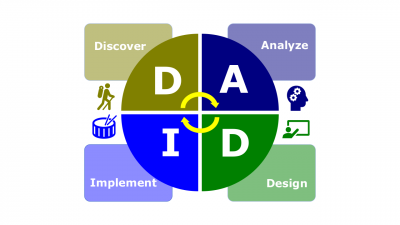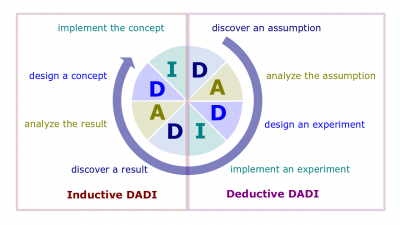DREPD
DREPD (alternatively known as Discover-Research-Envision-Plan-Do Cycle and DREPD cycle; also historically known as DRMP, Discover-Research-Model-Plan Cycle, DRMP loop, and DRMP method; hereinafter, the Method) is the iterative four-step method used to manage any enterprise effort that that enterprise effort in four consecutive batches: Discovery (D), Research (R), Envisioning (M), and Planning (P). The name of the Method is the abbreviation of four verbs: Discover, Research, Envision, Plan.
The Method is used in any development in two ways:
- Being complex, the Method can serve as a canvas for the development cycle as a whole. In this case, one bigger complex Method may consist of a number of smaller Patterns, which are called basic; and
- Being basic, the Method can serve as a layout for simple actions in new product development, problem solving, competitive strategy, business analysis, systems engineering, project management, etc. A combination of those basic Patterns can be presented as a complex Pattern.
In education, Bracka School also deploys the Method while building the curricula on multiple sets of four quarters, each of which represents one batch of the Method.
Components
Discovery
- Main wikipage: Enterprise discovery
- The first batch of the Method is Enterprise discovery. It includes all activities resulted in discovery of any data relevant to the further enterprise development. These data include some statement of the business need that is sought to be satisfied as the key outcome from that enterprise as a whole.
Research
- Main wikipage: Enterprise research
- The second batch of the Method is enterprise research. It includes all activities needed to process the data discovered in enterprise discovery in order to provide enterprise envisioning with detailed requirements for the future outcome from the Method.
Envisioning
- Main wikipage: Enterprise envisioning
- The third batch of the Method is enterprise envisioning. It includes all activities needed to conceptualize, design, scratch, model, map, plan, project, and/or detail the Method's outcome and/or finalize the architecture or layout for this outcome.
Planning
- Main wikipage: Enterprise planning
- The fourth batch of the Method is enterprise planning. It includes all activities needed to create and deliver the Method's outcome based on its architecture or layout made in enterprise envisioning.
Classifications
Classifications of the Patterns are tentative. Every Method has some agility and no Method can fully fall in one exact category. Thus, the taxonomies below serve to demonstrate various directions of various Patterns rather than precise classifications.
Basic vs complex
- Ideally, a basic Method is any development pattern that doesn't include other Patterns. For example, a generic reply like "Oh, really?" in a common conversation can be considered as basic. The listener (a) listens (or discovers) to its conversational partner, (b) researches what he or she has said, (c) decides what to reply (or models the reply), and (d) delivers (or plans) it;
- Ideally, a complex Method is any development pattern that includes other Patterns. For example, development of a new space ship requires millions should be considered as complex because it includes millions and millions basic Patterns.
Complete vs partial
- Ideally, a complete Method is any development pattern that includes all four batches from enterprise discovery to planning. For example, a generic reply like "Oh, really?" in a common conversation can be considered as complete because the entry data for this reply was collected, researched, the reply was designed and delivered;
- Ideally, a partial Method is any development pattern that doesn't include enterprise planning. This Method may or may not include enterprise envisioning if the Method includes enterprise research. This Method may or may not include enterprise research, but always include enterprise discovery. For example, development of a new space ship was ordered, but the project was stopped in the middle because of the lack of funding.
Transitional vs terminal
- Ideally, a transitional Method is undertaken in order to get some deliverable, which will be used in some Method in the future. For instance, a traveler takes a taxi in hopes that his or her driver would give more information on what to visit in a city, which hasn't been known to him or her yet. The traveler's airplane is unexpectedly delayed for one day;
- Ideally, a terminal Method is undertaken in order to get with some deliverable, which will not be used in the future by the undertaker. For instance, someone delivers a pack of generic Vitamin C to its buyer.
Predefined-deliverable vs unexplored-deliverable
- Ideally, a predefined-deliverable Method is undertaken in order to get with some deliverable, which features are defined before the Method starts. For instance, someone needs to buy a pack of generic Vitamin C;
- Ideally, an unexplored-deliverable Method is undertaken in order to get some deliverable, which features cannot be exactly defined before the Method starts. For instance, a traveler takes a taxicab in order to get to a city, which hasn't been known to him or her yet, because the traveler's airplane is unexpectedly delayed for one day and he or she is looking for ideas how to spend that "extra" day.
Deductive vs inductive
- Ideally, a deductive Method is undertaken in order to create a concept out of other concepts and experiments. For instance, the Patern is created out of similar concepts such as PDCA and experiences;
- Ideally, an inductive Method is undertaken in order to conduct an experiment. For instance, the Patern can be tested in any enterprise effort.
Applications
New product development, problem solving, competitive strategy, portfolio administration, business analysis, systems engineering, project management and many other concepts are built on the basic Patterns. Complete complex terminal Patterns seem to have strong correlations with other concepts as well.
In project management
- With one exception of discovering a business need, which project deliverables shall satisfy, the complex Method can serve as a project management canvas itself. One or more the basic Patterns can be used in order to create or modify any output of any project management process such as a project charter, stakeholder register, acceptance criteria, etc.
Complex Patterns vs other development concepts
- Although the table below is not intended to be complete, it addresses some tendencies and correlations between the complete complex terminal Patterns, on the one hand, and some other other development concepts, on the other hand:
Discovery Research Envisioning Planning Business need Requirements data Portfolio administration Usually, c-level executives define the needs at the organizational level, as well as frontline managers at the lower levels and middle managers in between those levels New product development Project management Systems engineering Usually, project teams or functional departments execute implementations Business analysis Solution architects or others can model the solution Competitive strategy Business need Requirements data Research Envisioning Planning Discovery
In education
- Bracka School has built its Septem Artes Administrativi curriculum on seven sets of four quarters. Each set is called quadrivium and designed around the Method.
Related concepts
- Deductive DREPD.
- Inductive DREPD.
- Viable DREPD. A pattern that consists of both Deductive DREPD and Inductive DREPD.

